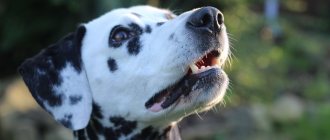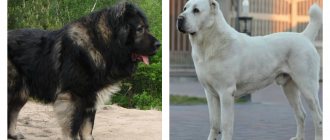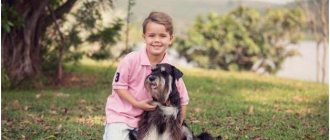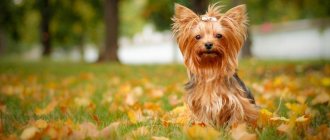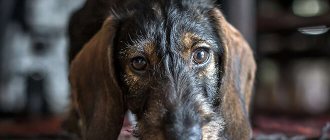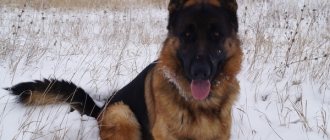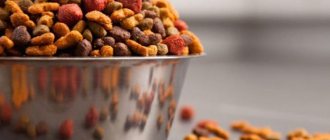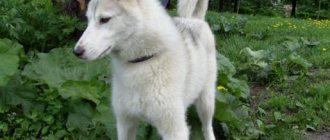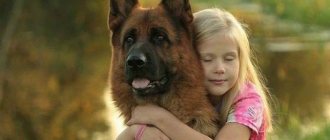| Origin: | USA |
| Usage: | sled dog |
| Color: | black, white, red and various combinations of gray |
| Dimensions: | height at withers 58-63 cm, weight 34-38 kg |
| Lifespan: | 12-15 years |
Every year new breeds of dogs appear in the world. But despite this, the Alaskan Malamute remains at the peak of popularity. A powerful, muscular and energetic animal with a good-natured character. However, raising a puppy plays a huge role. To ensure that the pet does not cause problems for household members and surrounding people, training and socialization should be carried out by an experienced dog breeder.
Breed standard
The Alaskan Malamute is a powerful and efficient animal. He is larger than other northern dogs, strongly built and muscular.
The weight of an adult dog ranges from 34-39 kg. The height at the withers reaches 63 cm. Females are slightly smaller than males. Despite the heavy bones and impressive size of the Malamute, it remains agile and agile.
Official description of the breed:
- the head is wide. The muzzle tapers slightly towards the nose, but does not become pointed. The good-natured expression, which is visible even in the photo, indicates a peaceful disposition;
- The ears are medium-sized, triangular, set wide and vertical. Due to their lush fur they appear quite small. They look straight, but when the dog runs, the Alaskan Malamute often puts them back. The tips are slightly rounded;
- eyes – brown, almond-shaped, slightly slanted. The look is interested and curious;
- jaws – strong, wide. Scissor bite. Lips do not droop;
- nose – color of the earlobe is black. The exception is the red malamute. His nose is brown;
- body – athletic, compact. Neck with a slight bend. The back is straight with a slight slope towards the croup;
- the tail is fluffy, medium set. Reminds me of a fan. Raised above the line of the back, but does not touch it and does not curl into a tight ring;
- limbs are strong, with enormous drafting capacity, located in the same plane. The hindquarters are very muscular and give impetus to the body when moving. The pads are wide and massive. Thanks to them, Malamute dogs do not fall into the snow. The space between the fingers is protected by fur. The claws are strong and short.
Malamutes have a dense and coarse coat. The guard hair (7.5-10 cm) has water-repellent properties and reliably protects the soft undercoat. During the warm season, the fur becomes less dense.
There are long-haired Alaskan Malamutes. They look impressive, but do not meet the breed standard.
The animal has a raincoat type of color. The most common is the gray-white Alaskan Malamute, whose photo resembles a wolf. However, the breed standard allows other colors:
- black and white;
- sable;
- blue;
- ginger.
Each dog has unique markings on its face - a kind of “hat” and mask, which can be seen in detail in the photo of the Alaskan Malamute.
The lower body and paws are predominantly white. Speckled or spotted colors are not desirable. A solid color can only be white.
The characteristics of the breed indicate that the animal does not know fatigue. It moves in a balanced manner - as efficiently as possible, using a minimum of effort. Noble qualities are noticeable by a proud posture. You can find out exactly what the dog looks like from the photo.
Any defects, including temperament, that negatively affect performance are considered serious defects. Disqualifying faults:
- Blue eyes;
- tendency towards aggression or cowardice.
Animals with obvious physical or mental disabilities are subject to disqualification.
According to the current standard, the Alaskan Malamute dog breed belongs to group 1: “Spitz and primitive breeds.”
Character
Alaskan Malamutes are kind and peaceful. Previously, they guarded Eskimo settlements, but now they have lost their protective qualities. They are non-aggressive and are not “one-owner” dogs.
The Malamute breed exhibits unmotivated anger due to:
- psychological trauma;
- abuse;
- lack of education.
These are pack dogs that require constant attention from the owner. They cannot be kept in a closed enclosure or on a chain. If the owner is unable to devote enough time to the pet, he will look for his “portion of love” from other people. But such behavior cannot be called betrayal. These are innate characteristics that you should familiarize yourself with before purchasing a Malamute puppy.
The dog's character is reminiscent of a good-natured, mischievous, but sometimes naughty child. However, an adult dog never loses self-esteem. Proud posture and head held high are his integral attributes.
Almost all Alaskan Malamutes cannot bark. But they howl and grumble expressively.
Application
The Alaskan Malamute is a sled dog designed for transporting goods. Puppies begin to be trained as soon as their joints and muscles are formed. Therefore, it is important to know to what age animals grow. They reach the size of adults by 7-8 months. However, it is better to wait up to a year for the bones to finally become stronger.
You can raise a puppy as a hunting assistant. He will work for the beast in deep snow. But he will turn out to be a useless guard. An animal can scare an uninvited guest with only one thing – its large size.
In Russia, Alaskan Malamutes are practically not used for their intended purpose. They are often found by fans of extreme recreation, hiking and cross-country skiing. The pet will be an excellent companion for a person involved in sports.
Price
There are quite a lot of huskies in Russia, including the ones in question. Their prices vary. It depends on the dog’s pedigree, its health, parameters, city, etc. ex-hand price of an Alaskan Malamute
We recommend working with competent breeders who have a good reputation. There are nurseries in Russia where elite representatives of the breed are bred. They are born from famous champion dogs. The cost of such pets is from 20 to 30 thousand rubles.
Socialization
Alaskan Malamute puppies are smart and intelligent. For proper development, you should alternate mental and physical exercises. Without regular exercise, they develop “bad habits”: howling, whining, digging, chewing objects. To avoid problems, socialization begins as early as possible.
Alaskan Malamutes combine good nature towards people and a desire to dominate. They should not be owned by novice dog owners. Before raising an animal, you should carefully study the characteristics of its temperament.
Until the age of 3, dogs are actively trying to take a leading position, so the correct hierarchy needs to be built at an early age. Only an experienced person can handle this task.
Raising a Malamute is not an easy task. Animals learn easily and quickly understand how life works in a human “flock.” Therefore, questions about how to train a puppy to use the toilet outside or teach him the simplest commands usually do not arise. However, not everything is so smooth.
Pets are capable of being incredibly stubborn if they do not consider the owner to be the leader. Training an Alaskan Malamute requires patience. Day after day he will have to prove that the owner is the undisputed leader. It is strictly forbidden to scream and use physical force, otherwise the person will lose authority in his eyes.
If the owner cannot overcome the dog’s stubbornness, it is better to entrust the puppy’s upbringing to an experienced dog handler.
In relation to small domestic animals, animals demonstrate a hunting instinct. Aggression towards dogs of the same sex is possible if the Malamute puppy is not introduced into the community of relatives in time.
Animals and children get along well. The dog will happily pull the sled, play catch, and fetch the ball. But it is better not to leave him with children without adult supervision. He may accidentally push or scare the child.
Training and education
Malamutes are very smart and agile, and these qualities appear almost from birth. A puppy of this breed begins to strive for leadership early. In his upbringing, one must show firmness and consistency, constantly give feasible physical activity, which should be increased as he grows older. You can start training immediately after purchasing a puppy, teaching him how to call, simple commands and, what is also important, how to be neat.
Steel endurance
It is important to know: innate good nature does not prevent dogs of this breed from being aggressive towards other dogs or chasing cats or birds.
Socialization of a Malamute is an important stage in his life. You can start visiting the training site from the age of 4 months, when the vaccination quarantine ends. In addition to teaching discipline, a Malamute puppy, communicating with other dogs, will certainly find friends for noisy games. At the same time, you should accustom your pet to extraneous sounds, passing cars and other irritants. Thus, you will strengthen his nervous system and make the dog’s living in the city comfortable. Many owners who plan to place a dog in a country house sometimes neglect these simple rules. As a result, the dog's socialization suffers; it feels uncomfortable on noisy city streets.
How to choose a puppy
Before choosing a puppy, you should definitely talk to the breeder. A good owner will definitely ask the buyer a few questions:
- whether he is familiar with the characteristics of the breed;
- does he have an idea about the features of socialization and training;
- whether he can provide proper care and maintenance.
He will also tell you everything about the breed – not only the pros, but also the cons. A dedicated person always tries to find the best home for his ward.
Healthy Malamute puppies should:
- have shiny fur, clean ears and eyes;
- have a lively and interested look;
- be active, friendly and curious.
Small Malamutes are a bit clumsy and look like teddy bears. The mother dog must allow potential buyers access to the offspring if the puppies are more than six weeks old. Showing aggression is a reason to refuse the purchase. Temperament defects can be inherited.
The Alaskan Malamute puppy is growing very quickly. At 5 months he already weighs about 25 kg.
Relevant products in the Online store:
Swissline
FORCE VITALE Corrective eye cream Living Water
from 7,275 rub.
Sisley
Cream-fluid for eye contour with black rose extract
from 9,080 rub.
MBR
CONTINUELINE PROTECTION SHIELD EYE Eye cream
from 9,825 rub.
VALMONT
V LINE Lifting cream for the skin around the eyes
RUB 14,364 RUB 20,520
All goods
Features of maintenance and care
The homeland of Malamutes is Alaska. They have long lived in the harsh arctic climate, easily winter outside and are not afraid of bitter frosts.
A private house with a spacious plot is best suited for maintenance. Here the dog will be able to throw out the energy seething in him without harming the owner and others.
The Alaskan Malamute in the apartment feels depressed and begins to play pranks - gnawing things, scratching floors and furniture, howling.
The animal has an innate passion for digging holes. It is impossible to wean a dog from this. Therefore, care should be taken to ensure that she does not dig under the fence and escape.
Combing
Animal fur requires attention. How to care:
- Combing is a mandatory procedure. During molting, which occurs twice a year, it is carried out every day. An Alaskan Malamute in an apartment sheds almost all of its undercoat. If the fur is not removed, the body will become covered with tangles;
- During other periods, it is enough to comb the coat once a week and use a slicker once a month to keep the undercoat in order.
The rest of the care is standard:
- rubbing the eyes – once every 7 days;
- ear cleaning – once a month;
- Trimming nails as they grow.
The fur between the pads is clipped or shaved to prevent slipping on hard surfaces.
Bathing
It is enough to bathe Alaskan Malamutes once every 2-3 months. To prevent coarse fur from becoming brittle after washing, it is simultaneously dried and combed.
Animals love to swim in rivers and lakes. This is how they protect themselves from heatstroke in hot weather.
Walk
To channel the Alaskan Malamute’s energy “in a peaceful direction,” it needs to be taken out for runs regularly. Without constant load it will become uncontrollable.
It is better to walk the Alaskan Malamute on a special area equipped with slides, obstacles and other structures. Here he can frolic to his heart's content.
Feeding
The pet is given either ready-made food or home-cooked food. Mixing both diets is not recommended. The gastrointestinal tract adapts to monotonous food, and sudden changes in dishes cause digestive upset.
The menu should contain several sources of protein:
- poultry meat;
- mutton;
- fish.
Additionally, the diet includes vitamin supplements and fatty acids.
Adult dogs are fed 2 times a day in strictly limited portions. To prevent them from gaining weight, the owner should control the amount of food consumed.
Reproduction and lifespan
An Alaskan Malamute that is well fed and cared for will live at least 14 years. The average lifespan of such a dog is 13 years. A professional breeder must be aware of the distinctive characteristics of huskies in order to select the correct male and female for breeding. So, for high-quality representatives of this breed:
- Triangular-shaped ears rounded at the edges.
- Curled tail.
- Brown iris.
- Strong legs.
- Long and hard fur.
It is desirable that the male and female are the same age. An important point is that there should be no blood relationship between them, otherwise the puppies will be born genetically defective. Malamutes are bred when the bitch is in heat, preferably on the 3rd day after its onset. It is better to organize the breeding of dogs on neutral territory.
Health
Alaskan Malamutes are strong and hardy animals. Average life expectancy is 12 years. Sometimes there are long-livers who reach the age of 17. With proper care and healthy parents, problems rarely arise.
Diseases
Some dogs suffer from:
- hemeralopia (night blindness);
- progressive retinal atrophy;
- hypothyroidism.
The greater weight of an adult Malamute also causes inconvenience. Because of it, joint diseases appear. Excess body weight only makes the situation worse.
Vaccinations
An Alaskan Malamute puppy needs the same vaccinations as other breeds. Vaccination is carried out at the age of:
- 7-8 weeks;
- 10-12 weeks;
- 6 months.
In the future, animals are revaccinated annually. The veterinarian can adjust the vaccination schedule based on the Alaskan Malamute's immunity and the presence of common diseases in a particular area.
Mini Malamutes – do they exist and what do they look like?
The dwarf malamute or “Alaskan Klee Kai” is an independent breed, the representatives of which, due to the mask on the face, look like a husky, but have a completely different character.
These dogs were bred from the mating of Alaskan Malamutes, Laikas and American Eskimo dogs.
Representatives of this breed, due to their calm nature and small size, do not require complex specific care or professional training skills. They tolerate frost well and are suitable for both outdoor and indoor use.
Alaskan Klee Kais grow up to be good friends and faithful companions of their owner, in addition, they become excellent nannies for children.
How much do Alaskan Malamute puppies cost?
The answer to the question of how much a puppy costs depends on its class:
- the price of animals without documents intended for the role of pets is from 8 to 12 thousand rubles;
- dogs with a pedigree are more expensive - 20-30 thousand rubles;
- the cost of show-class babies is 50-100 thousand rubles.
To purchase a healthy dog, you should only contact trusted breeders.
Nurseries
In Russia, Alaskan Malamute puppies are sold in many nurseries:
- “Alveig” https://www.malamute-akbar.ru/ in St. Petersburg;
- "Mel Planet" https://www.alaskan.ru and "HOGVARTZ MAG" https://hogvartz-mag.ru/ in Moscow.
Reviews from owners confirm that Alaskan Malamutes are active, hardy and friendly dogs. A purebred dog must have qualities that would allow him to work successfully in his homeland. For a happy and fulfilling life, your pet needs space and competent guidance from an experienced dog breeder.
How long do pets live?
How long do dogs live on average? These fluffy beauties are not record holders in terms of longevity. Their average lifespan is between 13 and 15 years. However, if you properly care for your four-legged pet and feed it properly, you can extend this period for several years. Typically, healthy Malamutes remain physically active and have good spirits until their last days.

